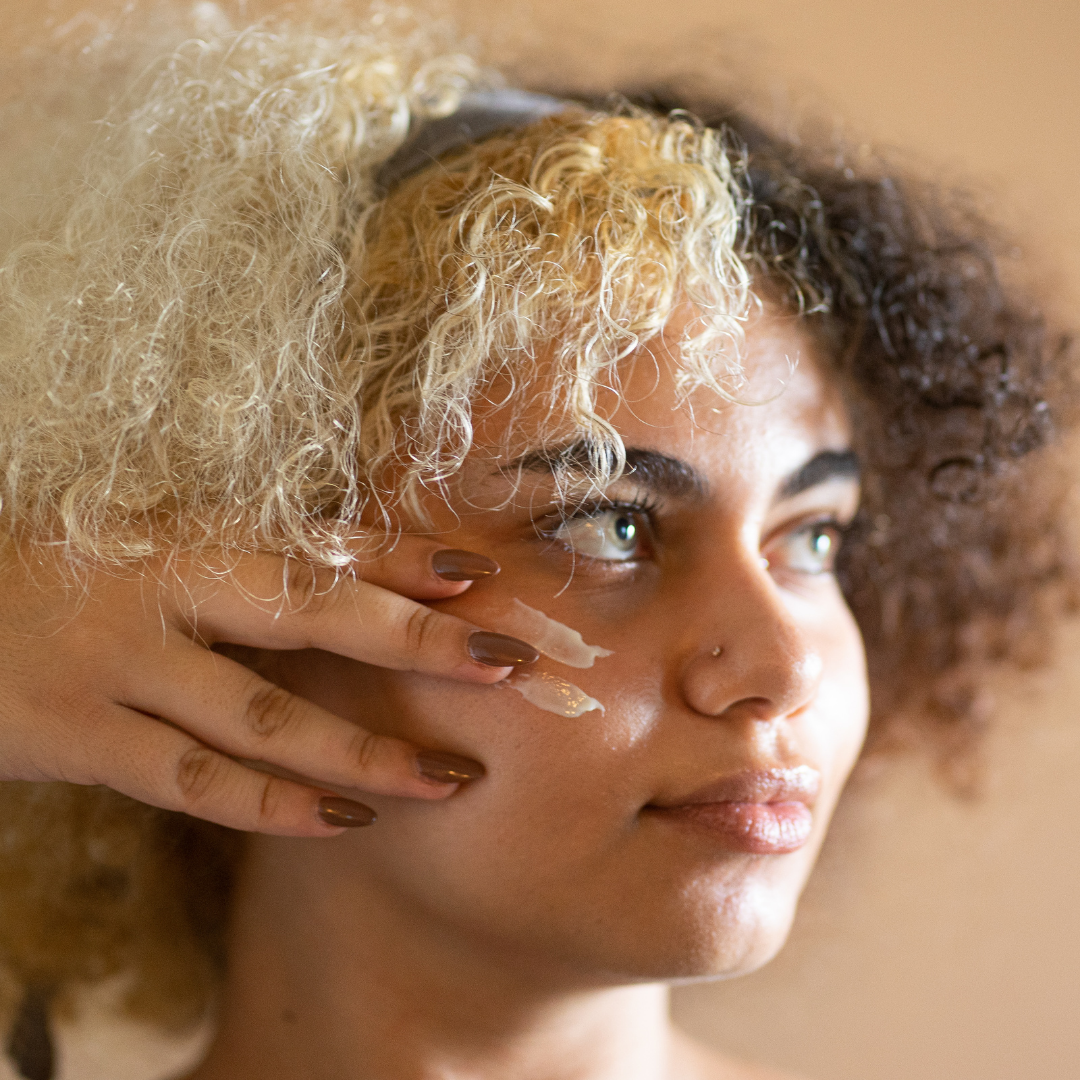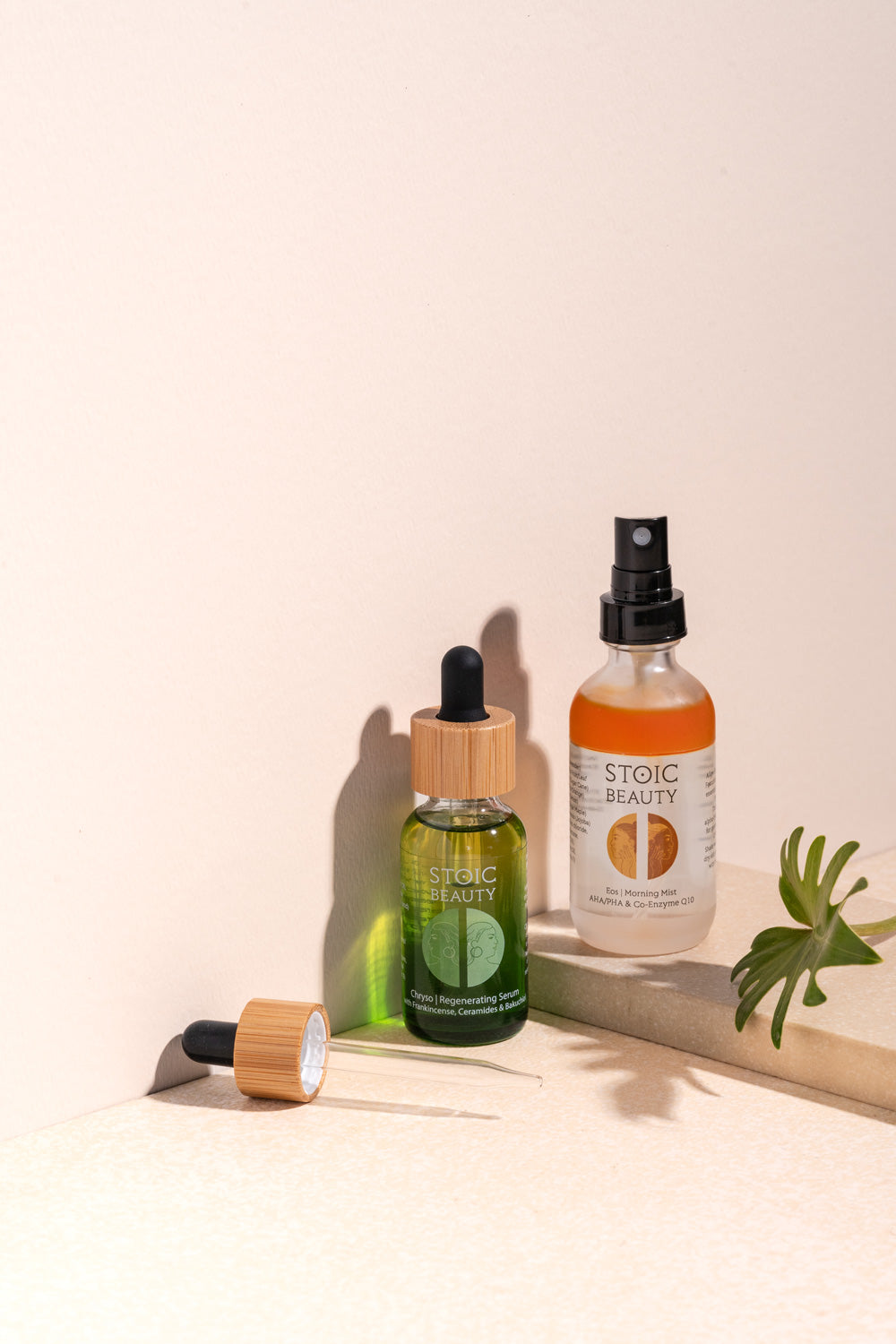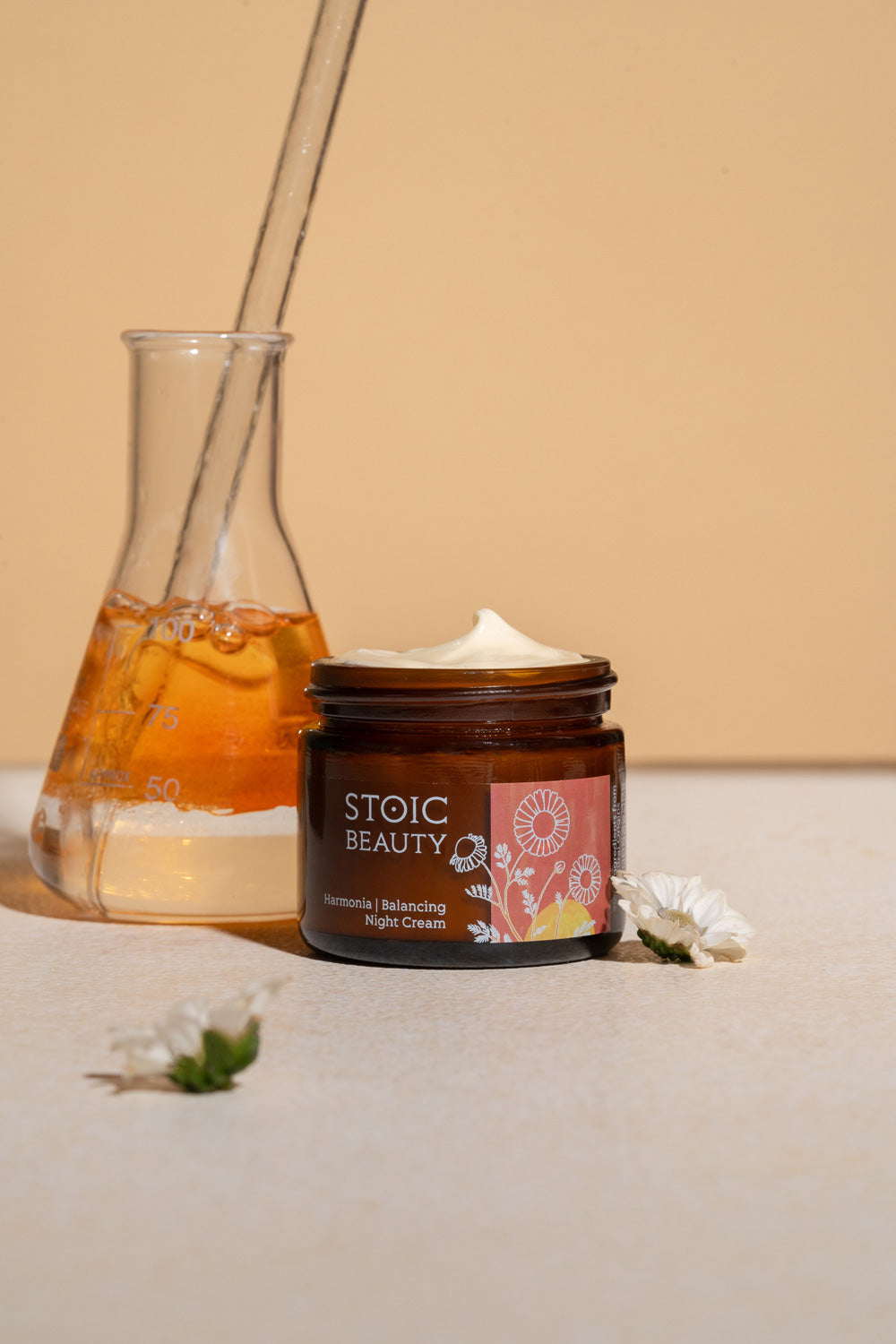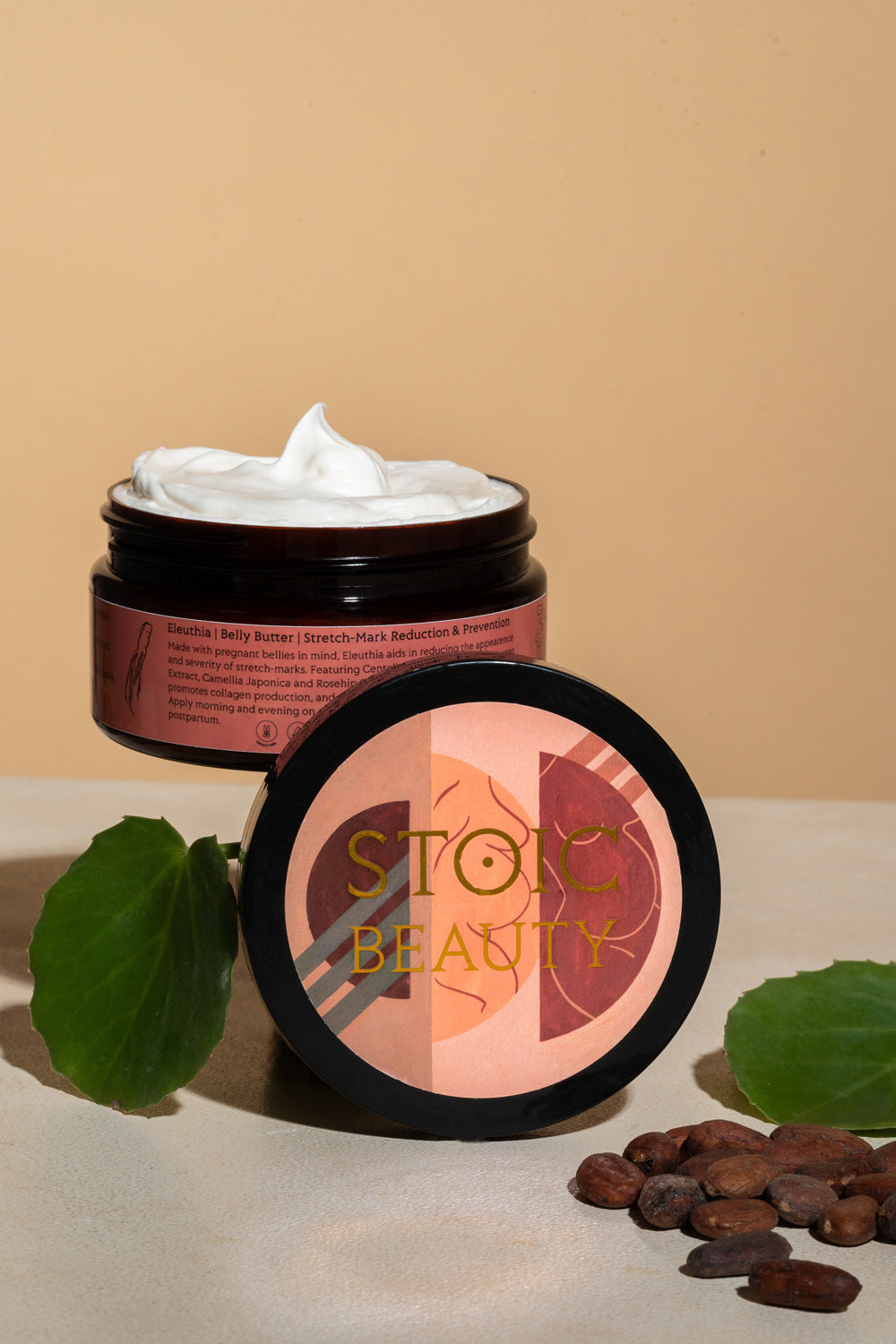

What are the best natural ingredients for rosacea? In this third and final blog post on the formulation of our Harmonia Golden Chamomile Night Cream. This series shone a spotlight on several ingredients that help reduce facial redness and provide deep moisturization to sensitive skin. Today, we’ll home in on ingredients with anti-inflammatory and barrier repair properties.
Anti-inflammatory agents
As I have mentioned before, skin inflammation is a feature of rosacea, acne, and many other types of dermatoses. As we discussed in Part 1, our star ingredient, the extract of golden chamomile (Chrysanthellum indicum) is rich in polyphenols with anti-inflammatory activity. The benefits of argan oil have been presented in part 2 of this 3-part blog series, which you can explore here.
Two other components of our Harmonia cream are naturally occurring anti-inflammatories: α-bisabolol and allantoin. α-Bisabolol extracted from German Chamomile, is a triple threat: it has anti-irritant and anti-microbial properties. Last, but not least, is sea buckhorn berry oil, chalk full of vitamin C, B, and E, lycopene, phytosterols, and numerous phenolic compounds with antioxidant properties... All that to say, it works to soothe inflammation and calm irritated skin, truly a natural panacea of skincare. Sea buckhorn berry oil is rich in mega-6 and omega-7 unsaturated fatty acids that help in repairing damaged skin.
Let’s Talk Strength: strong skin is hydrated skin.
Our first formulation task is to strengthen the Epidermal Barrier Function. Remember: Strong skin = hydrated skin.
Deficiency in skin barrier function is observed in rosacea, acne, various other dermatoses and in the natural process of skin aging. Consequently, we’d expect that any treatment leading to the restoration and support of this function would be beneficial to these skin types.
Let’s start with niacinamide (vitamin B3) an increasingly popular cosmetic ingredient which use in skin care deserves special attention. As my daughter likes to say, if niacinamide were a zodiac sign, it would be a perfect libra: restoring balance and a great helper ingredient to boost efficacy of other actives. Niacinamide improves epidermal barrier function, evens skin color and texture, decreases inflammation, helps in rosacea and acne, and reduces the appearance of signs of skin aging.
In a double-blind placebo-controlled clinical trial1 niacinamide cream (5%) prevented red blotches and hyperpigmentation and produced small but statistically significant reduction in fine lines and wrinkles at the end of a 12-week treatment. The treatment significantly reduced skin yellowing and sallowness characteristic of skin aging and related to an oxidative process of glycation. What is glycation? Think: sugar, sugar, sugar! Sugar molecules attach themselves to other molecules, like fats and proteins. And much like too much sugar in the diet, these sugar molecules cause some havoc! They can attach themselves to collagen, and suddenly youthful suppleness is in jeopardy. Niacinamide brings that plumpness right back.
Several studies2,3 demonstrated that application of niacinamide (2%) cream improved epidermal barrier function measured as a decrease in trans-epidermal water loss (TEWL). Looking closer at the mechanism of efficacy, researchers noted increased biosynthesis of skin ceramides, cholesterol, and free fatty acids… all this leading to improvement of the skin barrier function. Consequently, in one study3 application of 2% niacinamide cream produced impressive results in rosacea. After four weeks of daily application of the cream, over 97% of patients showed significant improvement.
Anti-inflammatory and barrier-repair properties of niacinamide are also beneficial in acne. A clinical study4 demonstrated that a 4% niacinamide cream was more efficacious in treating acne that a 1% clindamycin (antibiotic) gel.
Niacinamide induces gentle exfoliation without necessity for low (acidic) pH. This is ideal not only for acne and rosacea prone skin, but for any sensitive skin type.
Now that we have strength, let’s continue to boost moisture! An effective moisturizer should have three things: an occlusive, humectant, and emollient function. For the layman: a barrier to water loss, a retainer of moisture, and a soother or softener.
We have included several humectants in our formulation, starting from more common like propanediol and glycerin, to less common sodium lactate and panthenol. Panthenol (aka. vitamin B5) improves skin barrier function and stimulates skin healing.
We chose to add N-acetyl glucosamine (NAG) to our cream because it is a precursor to hyaluronic acid. It boosts hyaluronic acid content in skin which is impossible to achieve with application of hyaluronic acid containing creams or serums. It improves skin cell turnover, strengthens skin matrix and thus restores skin suppleness.
N-acetyl glucosamine works well with our libra-oriented niacinamide: the partners work to reduce hyperpigmentation. This is an added benefit for all pigmented and sensitive skin types prone to developing pigmented scars. In an 8-week, double-blind, placebo-controlled clinical trial5 application of 2% NAG reduced the appearance of facial hyperpigmentation. In a second study with a combination of 2% NAG and 4% niacinamide, the effect on hyperpigmentation was even greater.
We use two plant-derived and biodegradable emollients in our cream: coco-caprylate and isoamyl laurate. Both are excellent natural skin conditioning agents and contribute to soft skin feel.
Emulium® Dolcea MB, the emulsifier we have selected for our cream significantly contributes to the epidermal barrier protection with its occlusive and emollient components. This 100% natural origin, COSMOS-approved, and 100% biodegradable emulsifier significantly improved skin hydration even after only a 7-day application (study by Gatteffosé). Remarkably, skin has remained hydrated for 48 hours after last application.
All this research led us to our final product, Harmonia. Who said you can have too much of a good thing? Okay. We do understand it is PACKED with actives. The balancing act of so many high-quality ingredients was our formulation challenge. We went through many, many, trials to not only deliver so many active ingredients, in a bio-available formulation, but also to create a silky smooth, luxurious skin product that is as multi-purpose as it is multi-ingredient. We hope you love it as much as we do.
1Bisset DL et al., Int J Cosmet Sci. 2004 Oct;26(5):231-8)
2Tanno O et al., Br J Dermatol. 2000 Sep;143(3):524-31
3Draelos ZD et al., Cutis, 01 Aug 2005, 76(2):135-141
4Shalita AR et al., Int J Dermatol. 1995 Jun;34(6):434-7
5Bissett DL et al., J Cosmet Dermatol. 2007 Mar;6(1):20-6




